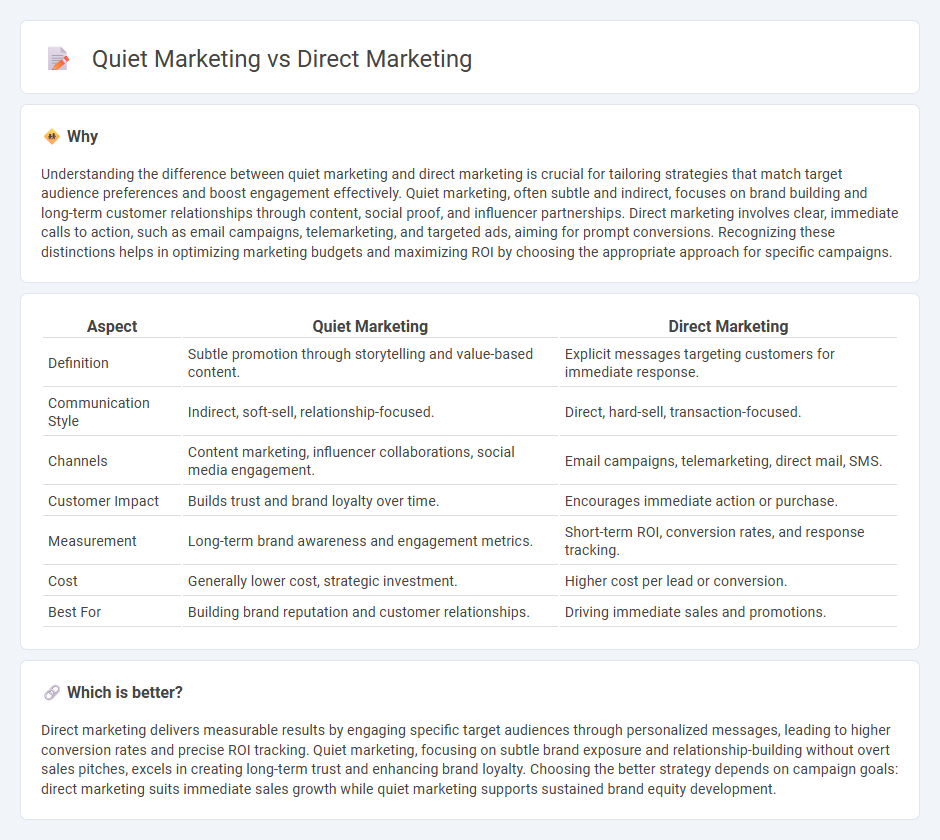
Quiet marketing leverages subtle, low-profile strategies to engage target audiences without overt advertising, focusing on brand reputation and customer experience. Direct marketing employs explicit, targeted communication methods such as emails, telemarketing, and direct mail to generate immediate responses and measurable results. Discover how these contrasting approaches can optimize your marketing strategy by exploring their unique benefits and applications.
Why it is important
Understanding the difference between quiet marketing and direct marketing is crucial for tailoring strategies that match target audience preferences and boost engagement effectively. Quiet marketing, often subtle and indirect, focuses on brand building and long-term customer relationships through content, social proof, and influencer partnerships. Direct marketing involves clear, immediate calls to action, such as email campaigns, telemarketing, and targeted ads, aiming for prompt conversions. Recognizing these distinctions helps in optimizing marketing budgets and maximizing ROI by choosing the appropriate approach for specific campaigns.
Comparison Table
| Aspect | Quiet Marketing | Direct Marketing |
|---|---|---|
| Definition | Subtle promotion through storytelling and value-based content. | Explicit messages targeting customers for immediate response. |
| Communication Style | Indirect, soft-sell, relationship-focused. | Direct, hard-sell, transaction-focused. |
| Channels | Content marketing, influencer collaborations, social media engagement. | Email campaigns, telemarketing, direct mail, SMS. |
| Customer Impact | Builds trust and brand loyalty over time. | Encourages immediate action or purchase. |
| Measurement | Long-term brand awareness and engagement metrics. | Short-term ROI, conversion rates, and response tracking. |
| Cost | Generally lower cost, strategic investment. | Higher cost per lead or conversion. |
| Best For | Building brand reputation and customer relationships. | Driving immediate sales and promotions. |
Which is better?
Direct marketing delivers measurable results by engaging specific target audiences through personalized messages, leading to higher conversion rates and precise ROI tracking. Quiet marketing, focusing on subtle brand exposure and relationship-building without overt sales pitches, excels in creating long-term trust and enhancing brand loyalty. Choosing the better strategy depends on campaign goals: direct marketing suits immediate sales growth while quiet marketing supports sustained brand equity development.
Connection
Quiet marketing leverages subtle, low-key promotional techniques that create authentic consumer engagement without overt advertising, complementing direct marketing's targeted communication methods focused on personalized messages and immediate responses. Both strategies prioritize building trust and fostering meaningful customer relationships through precision and discretion. Integrating quiet marketing with direct marketing enhances customer retention by combining subtle brand presence with clear calls to action.
Key Terms
Personalization
Direct marketing emphasizes targeted messaging through personalized emails, SMS, and tailored offers to engage specific customer segments effectively. Quiet marketing leverages subtle personalization techniques, such as personalized product recommendations and content that builds trust and loyalty without overt selling. Explore how personalization strategies differentiate direct and quiet marketing to enhance customer experience and conversion rates.
Outreach
Direct marketing relies on targeted outreach campaigns using emails, calls, and advertisements to engage potential customers with clear, persuasive messages. Quiet marketing emphasizes subtle, relationship-based outreach through content creation, social media interactions, and word-of-mouth to build trust and long-term brand loyalty. Explore more to understand how each strategy can optimize your marketing outreach efforts effectively.
Subtlety
Direct marketing aggressively targets consumers with clear calls to action, using explicit messages and promotional content to drive immediate responses. Quiet marketing embraces subtlety, relying on indirect brand exposure, storytelling, and emotional resonance to build trust and long-term customer relationships without overt selling. Explore how subtle marketing strategies can enhance brand perception and customer engagement by learning more about quiet marketing techniques.
Source and External Links
What Is Direct Marketing? Definition, Examples, and Guide - Direct marketing delivers targeted advertising messages straight to potential customers, using channels like email, social media, and direct mail, focusing on personalized communication rather than mass distribution.
What is Direct Marketing: Definition and Examples - Direct marketing is a campaign designed to initiate a personal relationship between the customer and the marketing organization, communicating directly with pre-selected customers and enabling a direct response, such as orders or purchase requests.
What is Direct Marketing? | Mailchimp - Direct marketing refers to promoting products or services directly to the target audience through various channels, allowing for personalized, cost-effective campaigns that improve over time with accurate customer data.
 dowidth.com
dowidth.com